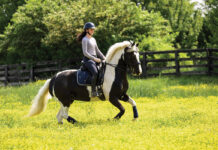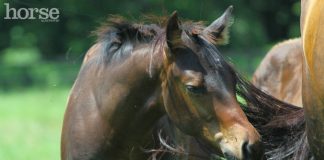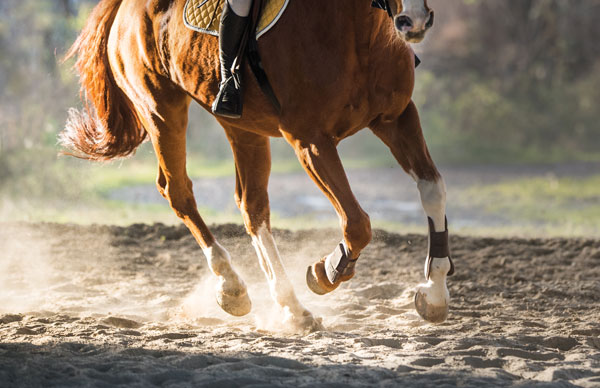
There are many reasons for a horse to have some time off, such as resting up after a strenuous competition season or the realities of life getting in the way. Injuries can also sideline a horse for months at a time. But by far the most common reason for an extended period of time off is winter: The weather is cold, the footing unpredictable, and the days are short. But as spring arrives, it is time to think about spring conditioning for your horse.
Loss of Fitness
It’s true that humans lose condition very quickly in just a few short weeks. However, the good news for your horses is that they don’t “detrain” as rapidly. A four- to six-week layoff shouldn’t pose an obstacle for bringing a horse rapidly back to his previous level of condition, assuming he was fit to begin with. Metabolic muscle adaptations are maintained for at least five to six weeks.
That said, a horse that has been completely idle for several months requires a sensible strategy for spring conditioning, as tendons and ligaments take the longest to get fit for exercise, and you certainly don’t want to cause an injury by doing too much too soon—this will put you right back to square one with another long layoff and complete loss of fitness.
If your horse needs a strategic plan to recondition after recovering from an injury, it’s important to consult with your veterinarian on the best way to safely leg him up.
Walking as Part of Spring Conditioning Your Horse
Bringing your horse back to work requires a dedicated effort and commitment on your part. The more diligently you apply a consistent program, the faster your horse will return to fitness and the stronger he will develop from the spring conditioning process. In general, after the first month of a layoff, a horse should be reconditioned for a month for every succeeding month he is rested.
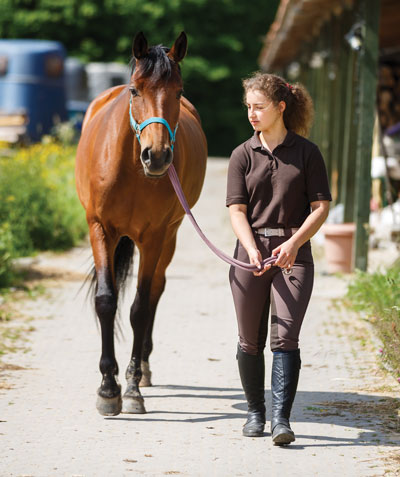
A specific strategy for returning and putting him to work depends on whether he has enjoyed pasture turnout over the winter or has been confined to a stall and run only. A horse that has been moving around out in the field generally retains some muscle tone and strength in soft tissue structures. This horse can usually withstand carrying you around at a walk without undue stress. The stalled/confined horse should be handled more carefully.
Start with controlled exercise in the form of hand-walking, beginning with 15 to 20 minutes each day on level ground with good footing.
If he is well-behaved, you could pony him beside a well-mannered horse at a walk. A general rule is to increase walking periods by five to 10 minutes every three to five days, working up to at least one hour daily.
As you target an hour of exercise, a week or two of progressively longer walks each day then enables you to continue the program from the saddle.
Trot and Canter
Once your horse has been walking for an hour for two to three weeks, you can introduce some slow jogging, either on a hot walker or by ponying next to a calm horse, or with you in the saddle.
The timing of when to introduce trot work depends on how much R&R your horse had
to start. Use the same principles you applied to the walking work: Exercise him on level ground with good footing.
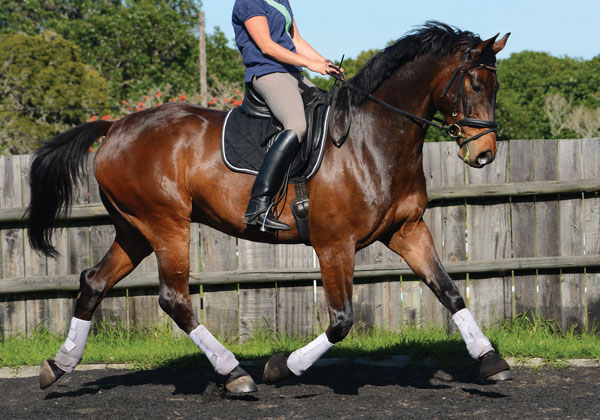
Substitute five minutes of trotting every three days for that much walking without lengthening the overall duration of exercise. In other words, within the hour of work, initially your horse walks 55 minutes and trots 5 minutes. The allotted trotting time is best interspersed throughout the hour rather than doing it all in one stretch. Be careful not to increase speed and duration at the same time.
As he adjusts to each incremental increase in exercise demand, you can work him for progressively longer periods. As trot time or duration of exercise increase, you may only need to exercise your horse three to five days a week to achieve results. After your horse is legged up well at the walk and trot, it’s time to put him back to canter work with progressive increases in time per session.
For horses that have benefited from light riding throughout the winter months, this conservative program can be accelerated by many weeks. It’s still wise to not ask for too much too soon in order to protect ligaments, tendons, muscles and joints. Most horses can return to their previous level of fitness within two to three months of a diligent reconditioning exercise routine.
Warm Up and Cool Down
Once you move past the initial legging-up period, you’ll have more trot work incorporated into each session. With any training program, you’ll want to spend five to 10 minutes of active walk and trot to warm up your horse.
This initiates a temperature and blood flow increase in the tissues. Tendons, ligaments and joint capsules improve in stretch. Joint lubrication improves, and muscles become more pliable and less at risk of injury. Circulation is geared up to deliver blood and oxygen to working muscles and to remove metabolic waste products.
Suppling exercises under saddle are helpful to prepare the tissues for work. This is achieved by bending your horse’s head and neck towards your foot while mounted, or by asking for a long and low (stretching) frame at all gaits. Other helpful exercises include leg-yields, shoulder-fore, and shoulder-in to improve lateral movements and flexibility of joints, ligaments and muscles.
A cool-down period of slow trot and/or walking redistributes blood flow away from the working muscles to other areas, like the intestines and internal organs. This minimizes the occurrence of colic or digestive upsets. Additionally, a cool-down period removes metabolic waste products (like lactic acid) and heat from the muscles to minimize post-exercise muscle soreness or cramping.
Diet and Hoofcare
Preventive health care and general maintenance of your horse are important throughout the year, regardless of season. For example, in winter climates, your horse’s energy needs increase in very cold temperatures as he burns calories to stay warm.
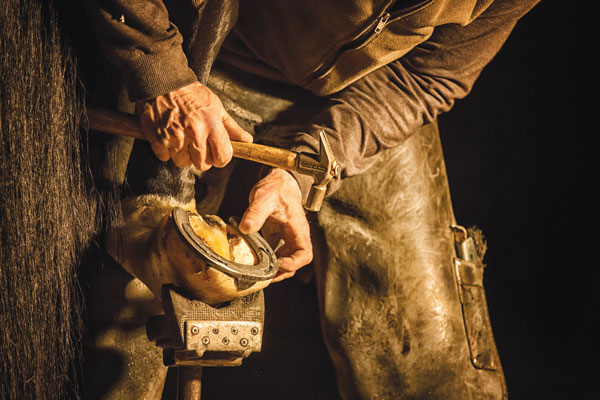
As spring temperatures warm, you’ll want to adjust and fine-tune his diet accordingly while accommodating his level of exercise. Warm weather requires fewer calories, but exercise burns more. Constantly monitor your horse’s body condition: you should be able to lightly run your hand across his ribcage and feel the last two ribs. An overweight horse puts more strain on his joints and has difficulty improving his fitness.
Another change in routine after winter involves hoof care. He may have been kept bare-foot during winter, but with regular exercise, it’s time to reapply shoes when appropriate.
Some horse owners prefer to use hoof boots instead of shoes to protect the soles and minimize excessive hoof wear with routine exercise. Regular farrier appointments—usually at four- to eight-week intervals, depending on the time of year and your horse’s unique rate of hoof growth—are important to maintain hoof balance and soundness.
Many horses benefit greatly from time off from a demanding work schedule. Two to three months of rest allows time for recovery and healing and for the mental relaxation of just being a horse.
A horse with a solid fitness foundation can be brought back relatively quickly following a couple months of rest. Horses recovering from an injury or from prolonged rest periods require more time and caution. In all cases, collaborate with your veterinarian on the best program to achieve your goals.
This article about spring conditioning for your horse appeared in the April 2020 issue of Horse Illustrated magazine. Click here to subscribe!



